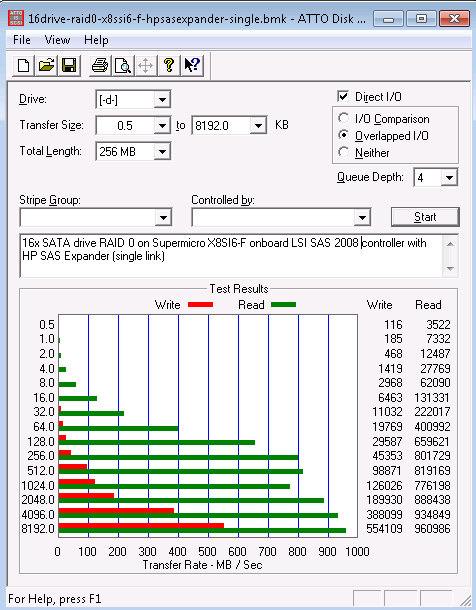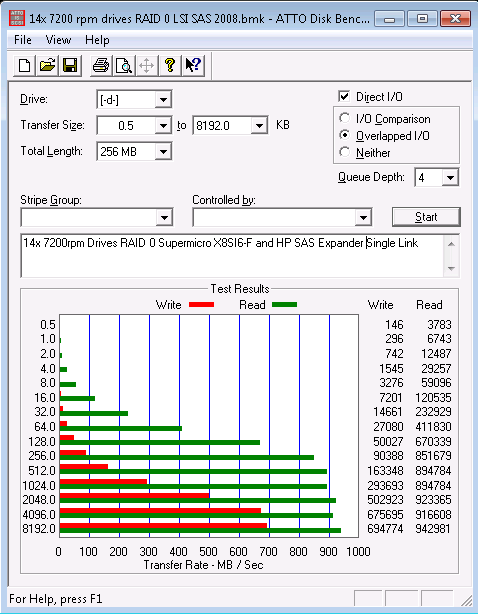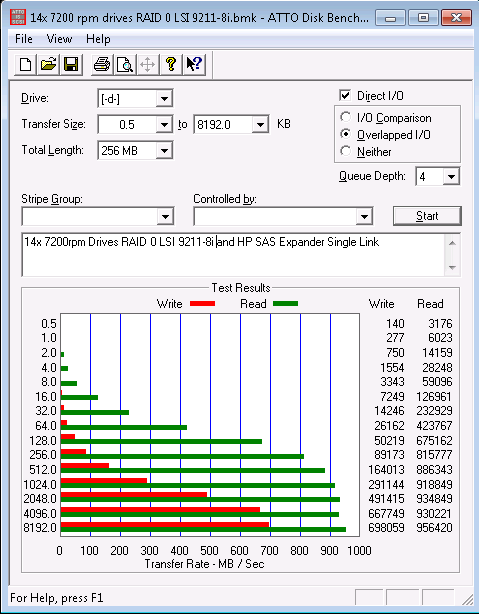The question of whether or not one can mix 7,200rpm hard drives with 5,400rpm (5,900rpm or other speed) “green” drives in RAID is one that I get asked constantly. My general advice is to not do it. While testing the Supermicro X8SI6-F and Supermicro X8SIL-F with a LSI 9211-8i (essentially making the setups very similar) I ran some Windows ATTO benchmarks which is a pretty decent benchmark for testing best case throughput.
So to answer the first question, “can it be done?” the obvious answer here is yes, one can setup a RAID array with different speed disks.
The second question is whether this is a good idea or not. I would offer that it is probably not best practice to add green drives to 7,200rpm disk RAID arrays.
Test configuration
Just to double-check my numbers I ran the tests on two different motherboards and two different controllers both based on the LSI SAS 2008 controller.
- CPU(s): Intel Xeon X3440
- Motherboard(s): Supermicro X8SI6-F and Supermicro X8SIL-F Rev. 1.02
- Memory: 8GB of Kingston ECC 1333MHz DDR3 KVR1333D3E9SK2/4G (Unbuffered)
- Case: Norco RPC-4220
- Controllers: Onboard LSI SAS 2008 (X8SI6-F), LSI 9211-8i (X8SIL-F)
- SAS Expander: HP SAS Expander
- Drive(s): OS 2x Intel X25-V 40GB
- RAID Array Disks: 2x WD Green 2TB (EADS 512B used not EARS 4K sector drives), 8x Hitachi 7200rpm 2TB, 6x Seagate 7200.11 1.5TB
- Power Supply: PicoPSU 150XT
- OS(es): Windows 7 Pro 64-bit
I created one large RAID 0 volume just to make sure that I was not going to get bottle-necked by parity calculations.
The ATTO Benchmark Results

It is interesting to note in the above graph that the sixteen drive setup of fourteen 7,200rpm drives and two WD Green drives yielded very nice read speeds of almost 1GB/s. Considering there was a single SFF-8087 link between the controller and HP SAS Expander, this was fairly close to the 1GB/s expected “limit” of that setup. In theory, 4x 3.0gb/s links would provide more bandwidth, however in practice SATA over SAS tends not to see much more than 1GB/s bandwidth through one SFF-8087 link. Write speeds, however, were a different story. On the larger size runs (4MB and 8MB) the write speeds were decent but not great. Below the 4MB size, 200MB/s was unattainable. I ran these tests at least 20 times each and it was a common theme.
Next, I decided to try the same setup removing the two WD Green drives and leaving the new RAID 0 array with fourteen 7,200rpm drives.

One will notice, there is a major difference here in terms of write speeds in the half MB to 2MB range when using two WD Green drives over 7,200rpm disks. The additional spindles do contribute for slightly higher 8MB reads, but realistically, a 2% difference is a margin of error between runs.
Finally, I had a control setup, both in the Supermicro X8SI6-F and also in the Supermicro X8SIL-F alongside a LSI 9211-8i. The results were very similar to the X8SI6-F’s setup, which makes sense because both setups use the LSI SAS 2008 controller.

This is basically on par with the X8SI6-F results as there was a +/- 3% variance in the runs between the two setups. Overall, not too bad! What is very startling is, of course, the difference between these numbers, even with 14 spindles and solid state drives for small file sizes. Current SSDs really make it hard to justify RAID 0 spindle disk arrays unless one requires lots of storage that is not able to be cached due to size and access patterns.
Conclusion
This, of course was using RAID 0 array which is completely impractical for a 14-16 drive setup in all but the most extreme conditions since the risk of data loss is so high. I do think that it shows a clear preference for sticking with 7,200rpm drives for a performance oriented array. There is a clear performance loss with the additional two WD Green drives in the RAID 0 array. On the flip side, in reality, the array was perfectly usable. Despite having major write speed differences, this would probably still be fast enough for saturating a single GigE link. With all of this being said, for a lot of media streaming applications, “green” drives from Seagate, Western Digital and Samsung fare very well. They also have significant advantages when it comes to power consumption, noise, vibration and heat generation. I think the illustration above shows that, despite sequential read/ write speeds being similar and the wisdom that more spindles equal more performance, it is probably best to segment 7,200rpm drives and “green” series drives into separate arrays.




Good read, thanks for the info.
I wonder, how good of an idea is to run WD Green drives in RAID? I hear they lack some piece of code in their firmware compared to the enterprise WD drives to be able to run in RAID smoothly.
Also I always wanted to ask you this, so which drives do you now prefer since you have a lot of them?
WD Green? Seagate LP? 7200.12/11? Hitachi? etc.
Paul: What you are referring to is TLER which basically is when a drive encounters a sector it cannot read it tries to perform “heroic recovery” and does everything it can to read that sector. As a result of this, it can often work for many seconds making it unresponsive to RAID controllers. The unresponsive disk appears to the RAID controller as a failed disk and it gets booted from the array. This will cause the array to rebuild utilizing the hot spare and the drive in question to be marked as failed.
Personally, I have been using a LOT of the Hitachi 2TB drives mentioned above. They are slightly noisier, use a bit more power, and are not the fastest 7,200rpm drives, but they work on all of my Adaptec, Areca and LSI controllers without issue, even when paired with a HP SAS Expander.
Then again, I have bought plenty of WD and Seagate drives this year also. Personally I think WD and Seagate have slightly easier RMA processes than Hitachi and that is important with lots of disks.
yeah TLER, I couldn’t remember it on the spot. I did hear that Hitachi drives are very good for RAID, as well as Samsung drives, although both of those brands are $40 more expensive in Canada ($100 Seagate LP, $140 Hitachi/Samsung equivalent).